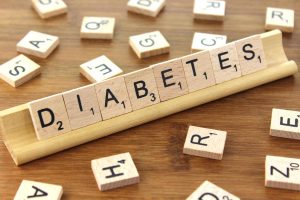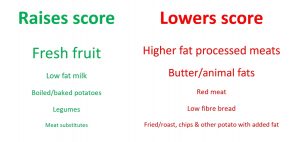By James Garbutt

When it comes to managing type 2 diabetes, there are lots of extreme diets out there with passionate advocates. Avoid carbs! Reduce fat! Restrict calories! However, researching the effects of diet on health in terms of single nutrient changes can be misleading. We don’t just eat single nutrients such as carbohydrates or fats on their own, we eat all kinds of combinations of nutrients from all kinds of different foods. How we combine all these foods together forms our ‘diet pattern’, and studying the health effects of diet in this more holistic way could offer insight into less extreme dietary management of type 2 diabetes.
What is type 2 diabetes?
For the majority of us, our blood glucose levels are kept in check by our pancreas. When we eat, carbohydrates in our food break down into glucose which then travels straight into our bloodstream. Our pancreas, sensing this increase in blood glucose, releases the hormone, insulin. Insulin, acting like a key, unlocks the cells of our body and shuttles the glucose inside, providing us with the energy we need to go about our day-to-day lives. Thankfully, our blood glucose levels return to normal.
In type 2 diabetes however, the cells of our body stop responding to insulin and our pancreas also stops producing as much. The insulin keys no longer fit the locks. Our body’s inner security systems fail to keep watch over us and our blood glucose levels begin to rise, bringing along for the ride a number of potentially serious complications.
Does diet matter for type 2 diabetes or is it all about weight loss?
Many types of diet have been shown to help blood glucose control in type 2 diabetes. Despite already being the focus of a lot of research, there is still no single diet that appears to win every time. Sometimes low-carbohydrate diets come out on top, at other times, low-fat diets. Very low-calorie diets are currently standard. Many people suggest weight loss is all that matters for improving blood glucose control, so whatever diet you can stick to will do the job. Lowering the amount of any macronutrient in your diet can instigate weight loss because your calorie intake is typically lowered as well. Maybe different diets can improve blood glucose control simply because they happened to help people lose more weight? However, eating carbohydrates (specifically, starches and sugars) does directly increase blood glucose after you eat them and constantly managing a large rise and fall of glucose may be an issue in its own right, regardless of weight loss. I wanted to try to make sense of what is going on here. Is dietary management of type 2 diabetes all down to weight loss or does the dietary pattern you eat matter too?
Using real-world data from people living with type 2 diabetes to find patterns in diet
Using a statistical technique called reduced-rank regression, I analysed real-life data on food intakes to find the best combination of foods (a diet pattern) that could separate people’s diets by the amounts of carbohydrate and fat that they contained. This allowed me to understand how people living with type 2 diabetes consumed foods which make their diets higher or lower in carbs or fats. Each person receives a score for how much their own diet follows this unique pattern. The most prominent foods in the diet pattern we found were (sized and in order of importance): We named it the ‘carb/fat balance’ diet pattern. Those who had higher diet pattern scores ate more fruit, milk, baked potatoes and beans alongside less processed meat, butter, white bread and chips, which translated into higher carbohydrates and less fat overall. None of the people we studied consumed extreme intakes of fat or carbs, rather intakes remained in the ‘normal’ range typical of diets commonly consumed in the UK. Hence the key word, ‘balance’. Higher scores also coincided with general improvements in diet quality; something which has been independently associated with cardiometabolic improvements in previous research.
We named it the ‘carb/fat balance’ diet pattern. Those who had higher diet pattern scores ate more fruit, milk, baked potatoes and beans alongside less processed meat, butter, white bread and chips, which translated into higher carbohydrates and less fat overall. None of the people we studied consumed extreme intakes of fat or carbs, rather intakes remained in the ‘normal’ range typical of diets commonly consumed in the UK. Hence the key word, ‘balance’. Higher scores also coincided with general improvements in diet quality; something which has been independently associated with cardiometabolic improvements in previous research.
Over time the diets we analysed became more balanced, moving closer to meeting UK healthy eating guidelines. We found that people with diets that became a more balanced intake of carbs and fats had better glucose control. Weight loss associated with better glucose control too, but even after we accounted for weight loss a small effect of diet pattern remained. While the improvement to blood glucose control from weight loss vs. diet pattern change was bigger, our results indicate that overall diet still has a role to play.
The conclusion? Weight loss is still king, but glucose control in type 2 diabetes could be improved further by maximising overall food quality and moving towards meeting UK dietary guidelines i.e. a moderate intake of both carbohydrates and fats. Demonising specific nutrients is certainly a simpler message but it fails to account for the complex interplay between different nutrients, foods and eating behaviours on health.
The old adage, ‘everything in moderation’, rears its head yet again.
James Garbutt, BSc MRes RD, PhD student in the Centre for Exercise, Nutrition and Health Sciences, School for Policy Studies. This blog relates to his recently published co-authored paper in BMC Medicine: Is glycaemic control associated with dietary patterns independent of weight change in people newly diagnosed with type 2 diabetes? Prospective analysis of the Early‑ACTivity‑In‑Diabetes trial.


